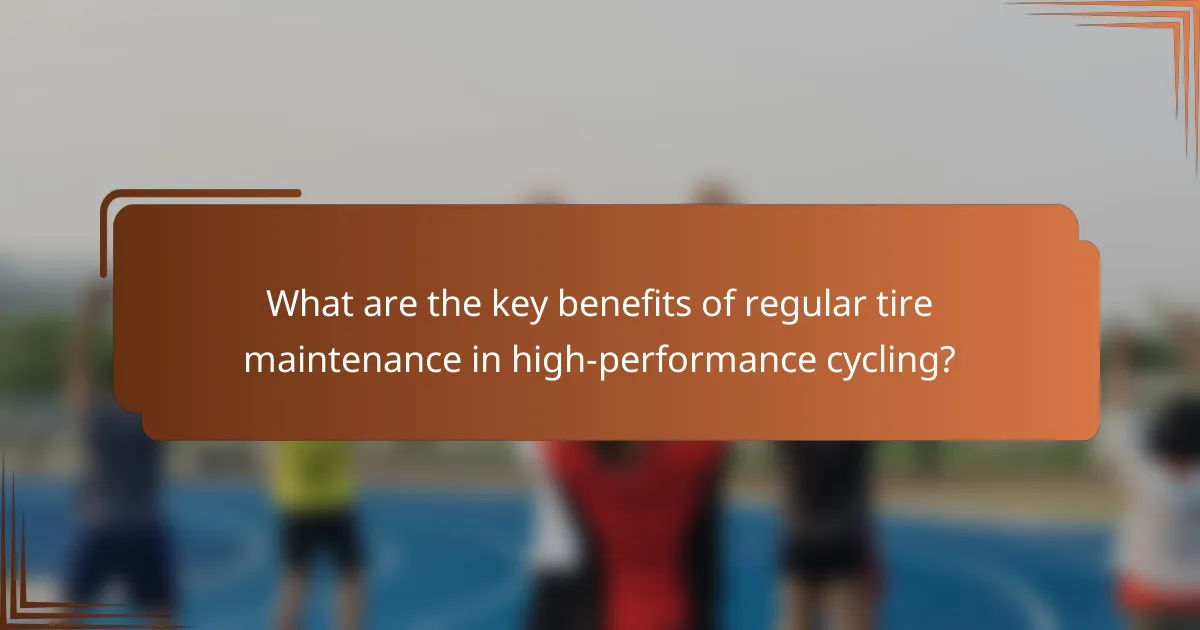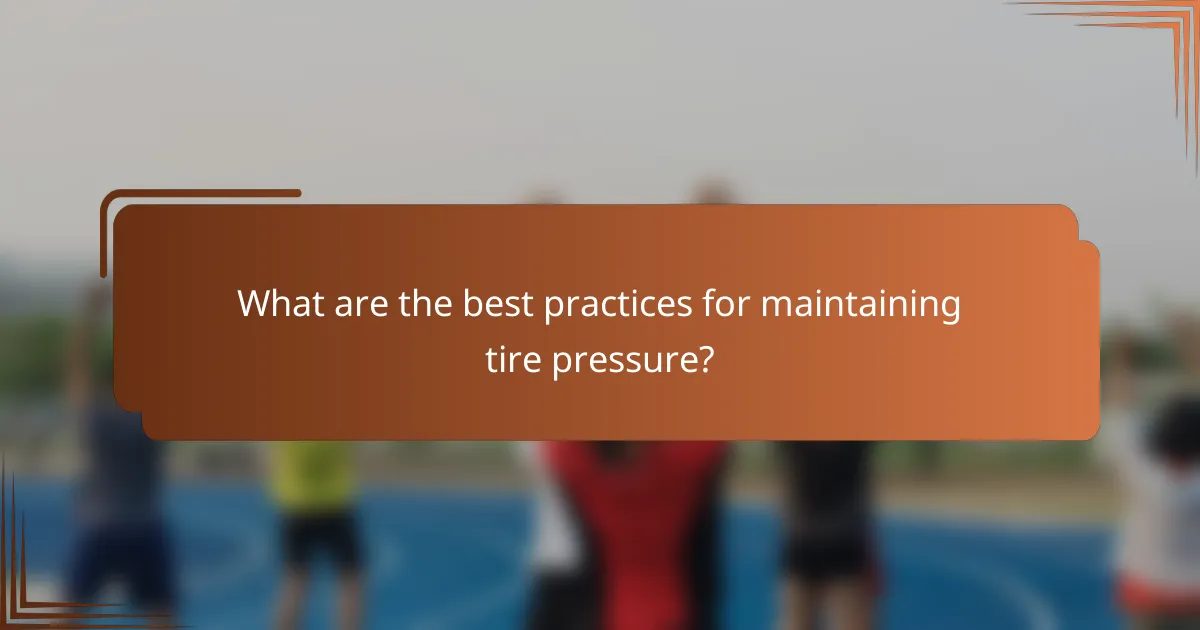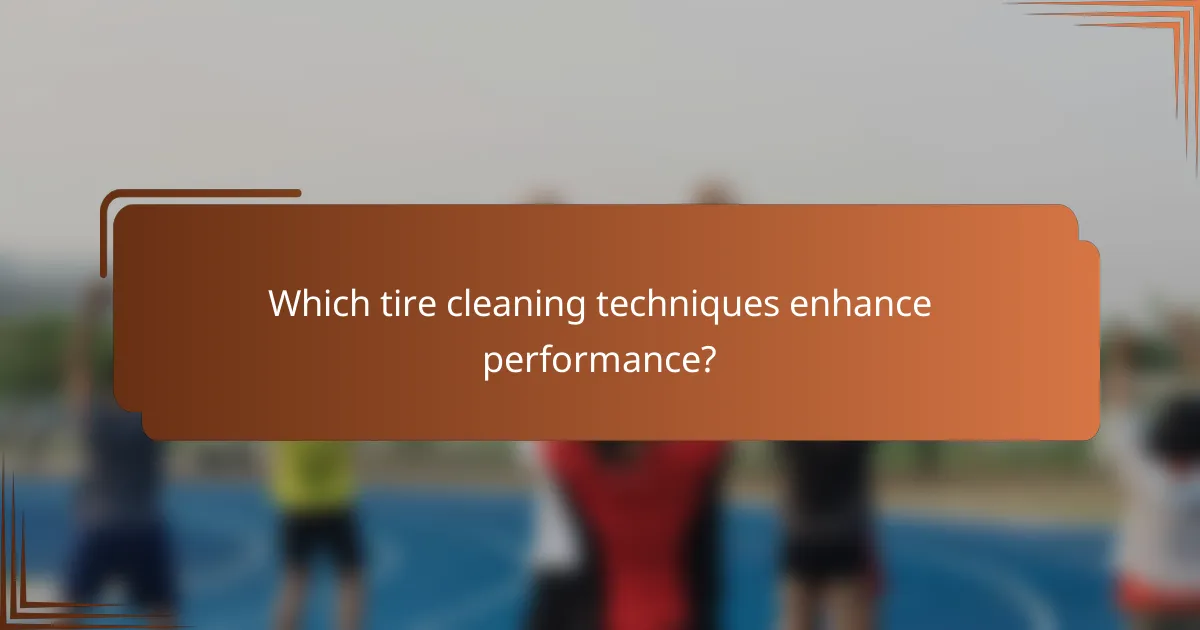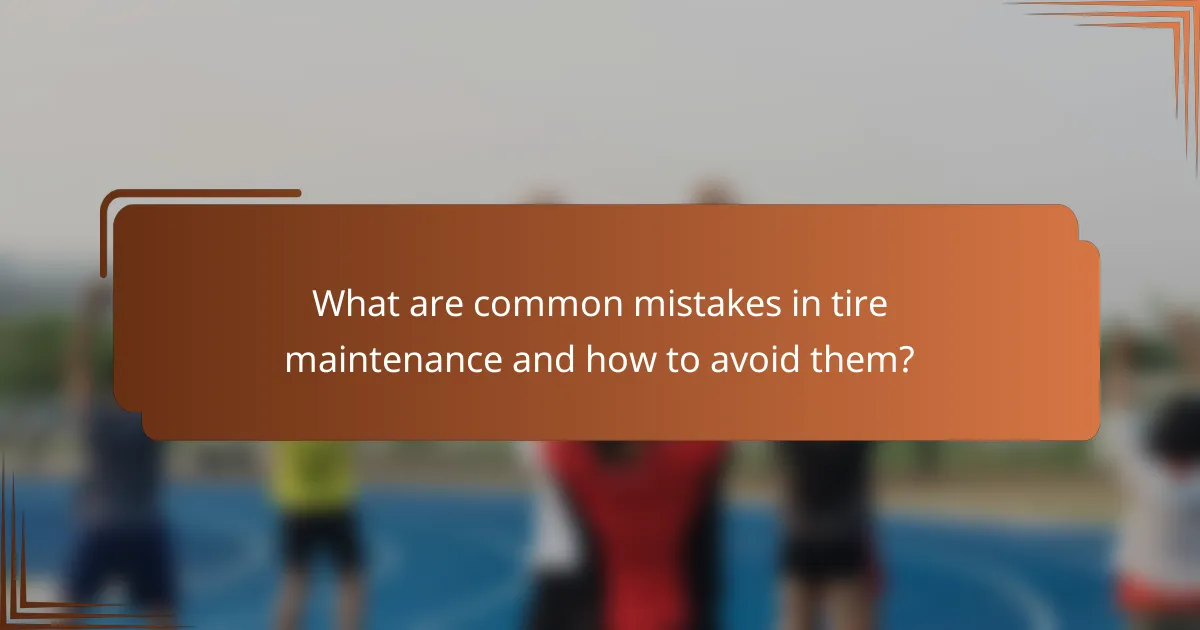Regular tire maintenance is crucial for enhancing performance and safety in high-performance cycling. This article covers essential strategies, including proper inflation techniques, routine inspections for wear and damage, and effective cleaning methods. Additionally, we will discuss maintenance tips tailored for various cycling conditions and common mistakes to avoid. Implementing these strategies can significantly extend tire lifespan and improve overall cycling experience.

What are the key benefits of regular tire maintenance in high-performance cycling?
Regular tire maintenance enhances performance, safety, and longevity in high-performance cycling. Proper inflation maximizes grip and minimizes rolling resistance, which leads to improved speed. Regular inspection prevents punctures and blowouts, ensuring rider safety. Additionally, maintaining tread depth optimizes traction in varying conditions, crucial for competitive cycling. Lastly, routine maintenance extends tire lifespan, reducing costs and enhancing overall cycling experience.
How does tire pressure affect performance and safety?
Proper tire pressure significantly enhances cycling performance and safety. Correct pressure optimizes grip, reduces rolling resistance, and improves handling. Under-inflated tires can cause sluggishness and increase the risk of pinch flats. Conversely, over-inflated tires may lead to decreased traction and a harsher ride. Regular pressure checks ensure optimal performance and safety, contributing to a more enjoyable cycling experience.
Why is tread depth important for high-performance cycling?
Tread depth is crucial for high-performance cycling as it directly impacts grip, handling, and safety. Adequate tread depth enhances traction on various surfaces, allowing for better cornering and braking performance. Insufficient tread depth can lead to reduced control and increased risk of accidents. Regularly checking and maintaining tire tread depth ensures optimal performance and extends tire lifespan. High-performance cyclists should aim for a minimum tread depth of 1.5 mm to maximize efficiency and safety during rides.
Which types of tires are best suited for competitive cycling?
For competitive cycling, high-performance tires designed for speed and grip are best suited. These tires typically feature a lightweight construction and a smooth tread pattern for reduced rolling resistance.
Common types include clincher, tubular, and tubeless tires. Clincher tires are easy to install and repair, while tubular tires offer superior performance and aerodynamics. Tubeless tires provide the advantage of lower pressure and reduced puncture risk.
Selecting the right tire depends on race conditions, terrain, and personal preference. For instance, slick tires excel on smooth surfaces, while slightly textured options perform better on mixed terrain.
Regular maintenance, including checking tire pressure and inspecting for wear, is crucial for optimal performance. Keeping tires in top condition enhances speed and safety during competitions.

How can cyclists effectively assess tire wear and damage?
Cyclists can effectively assess tire wear and damage by regularly inspecting tread depth, checking for sidewall cracks, and monitoring tire pressure.
First, measure tread depth with a gauge; replace tires when they reach the minimum threshold of 1.6 mm. Next, examine sidewalls for cuts or bulges, which indicate structural damage. Lastly, maintain proper tire pressure to prevent uneven wear and enhance performance. Regular assessments can extend tire lifespan and ensure safety during rides.
What visual indicators should cyclists look for?
Cyclists should look for tire wear indicators, pressure levels, and surface damage. Regularly check tread depth for even wear patterns. Uneven wear may signal alignment issues or improper inflation. Look for cuts or punctures that could compromise tire integrity.
How often should cyclists inspect their tires?
Cyclists should inspect their tires before every ride and perform a thorough check at least once a month. Regular inspections help identify wear, damage, and proper inflation, ensuring optimal performance and safety. Tires should be checked for cuts, punctures, and tread wear. Maintaining tire pressure within the recommended range enhances grip and reduces the risk of flats. Additionally, consider seasonal changes, as temperature fluctuations can affect tire pressure and performance.

What are the best practices for maintaining tire pressure?
To maintain optimal tire pressure, regularly check the pressure, adjust according to manufacturer specifications, and inspect for damage. Consistent monitoring ensures performance and safety in high-performance cycling.
1. Check tire pressure weekly, especially before long rides.
2. Use a reliable gauge for accurate readings.
3. Inflate tires to recommended PSI for your specific bike and riding conditions.
4. Inspect tires for punctures, wear, or damage regularly.
5. Store the bike in a cool, dry place to prevent pressure loss.
6. Consider temperature fluctuations, as they can affect tire pressure.
How does temperature influence tire pressure readings?
Temperature significantly impacts tire pressure readings, as warmer conditions increase pressure while cooler temperatures decrease it. This fluctuation can affect cycling performance and safety. For high-performance cycling, maintaining optimal tire pressure is crucial for efficiency and handling.
As temperature rises, air molecules within the tire expand, leading to higher pressure. Conversely, cooler temperatures cause air contraction, resulting in lower pressure. Regularly checking tire pressure before rides ensures optimal performance and prevents issues like blowouts or poor traction.
Cyclists should adjust tire pressure based on weather conditions. For example, a 10°F change can alter tire pressure by approximately 1 psi. Monitoring these changes helps maintain the ideal pressure range for different riding conditions.
What tools are essential for accurate pressure measurement?
Essential tools for accurate pressure measurement include a high-quality pressure gauge, a digital inflator, and a tire pressure monitoring system. These tools ensure precise readings, which are crucial for optimal tire performance in high-performance cycling. A reliable pressure gauge provides instant feedback, while a digital inflator allows for quick adjustments. Tire pressure monitoring systems offer real-time data, enhancing safety and efficiency during rides.

Which tire cleaning techniques enhance performance?
Regular tire cleaning enhances performance in high-performance cycling by improving grip and reducing rolling resistance. Effective techniques include using specialized tire cleaners, maintaining proper air pressure, and regularly inspecting for debris.
1. Use a non-abrasive tire cleaner to remove dirt and grime.
2. Rinse thoroughly to avoid residue that can affect traction.
3. Inspect tires for wear and damage during cleaning.
4. Store tires in a cool, dry place to prolong lifespan.
These strategies ensure optimal tire performance and safety during cycling.
What cleaning agents are safe for high-performance tires?
Use pH-neutral cleaners specifically designed for high-performance tires. Avoid harsh chemicals that can degrade tire materials. Safe options include specialized tire cleaners, mild soap solutions, and water-based cleaners. These products maintain tire integrity while effectively removing dirt and grime.
How can regular cleaning extend tire lifespan?
Regular cleaning can significantly extend tire lifespan by removing debris and contaminants. Dirt, grime, and moisture can cause premature wear and damage to tires. Cleaning tires helps maintain optimal traction and performance, reducing the risk of blowouts. Regular inspections during cleaning can also identify potential issues early, allowing for timely repairs. This proactive approach enhances safety and maximizes the value of high-performance cycling tires.

What unique strategies exist for different cycling conditions?
Effective strategies for tire maintenance in high-performance cycling vary based on cycling conditions. In wet conditions, prioritize tread depth and tire pressure to enhance grip. For dry terrains, maintain optimal tire pressure for reduced rolling resistance. In mountainous areas, consider wider tires for better stability. During winter cycling, use tires designed for cold weather to prevent slipping. Regularly inspect tires for wear and replace them as needed to ensure safety and performance.
How should tire maintenance differ in wet versus dry conditions?
Tire maintenance should be more frequent and thorough in wet conditions compared to dry conditions. Wet surfaces reduce traction, requiring proper tread depth and inflation adjustments.
In wet conditions, check tire pressure regularly; lower pressure can enhance grip but may increase wear. Ensure tread is adequate to channel water away, reducing hydroplaning risk. Inspect tires for damage, as wet conditions can exacerbate existing issues.
In dry conditions, maintain proper inflation and monitor tread wear, focusing on even wear patterns. Regularly clean tires to remove debris that may affect performance. While wet conditions demand vigilance, dry conditions require a focus on longevity and stability.
What adjustments should be made for off-road cycling?
Adjustments for off-road cycling include selecting appropriate tire pressure, tread patterns, and maintaining tire integrity. Lower tire pressure enhances traction on uneven terrain, while wider tires provide better stability. Regularly inspect for punctures and wear to ensure optimal performance.

What are common mistakes in tire maintenance and how to avoid them?
Common mistakes in tire maintenance include neglecting pressure checks, ignoring tread wear, and failing to rotate tires. To avoid these issues, regularly check tire pressure, monitor tread depth, and adhere to a rotation schedule. Maintaining optimal tire pressure enhances performance and safety, while rotating tires ensures even wear. Additionally, inspect for damage and replace tires when necessary to prevent accidents.
What misconceptions do cyclists have about tire care?
Many cyclists mistakenly believe that tire pressure is the only factor affecting tire performance. In reality, misconceptions about tire care can lead to decreased efficiency and increased risk of flats.
Cyclists often overlook the importance of regular tire inspections. Checking for wear, punctures, and proper alignment is crucial for maintaining optimal performance. Additionally, many riders underestimate the impact of tire compound and tread pattern on grip and rolling resistance.
Another common misconception is that all tires are created equal. In high-performance cycling, selecting the right tire for specific conditions is essential. Factors like weather, terrain, and riding style should influence tire choice.
Lastly, some cyclists believe that tires do not require maintenance beyond inflation. In fact, proper cleaning and storage can extend tire life. Regularly rotating tires can also help ensure even wear, enhancing overall performance.
How can improper maintenance lead to performance issues?
Improper maintenance can significantly degrade tire performance in high-performance cycling. Neglecting regular checks can lead to issues like reduced grip, increased wear, and compromised safety. For instance, under-inflated tires can result in higher rolling resistance, affecting speed and efficiency. Additionally, worn-out tread can lead to poor traction, especially in wet conditions, increasing the risk of accidents. Regular inspections and timely replacements are essential to maintain optimal performance and safety on the road.
What expert tips can enhance tire longevity and performance?
Regular maintenance and proper care significantly enhance tire longevity and performance in high-performance cycling. Key strategies include maintaining optimal tire pressure, regularly inspecting for wear and damage, and ensuring proper alignment and balance.
Maintaining tire pressure is crucial. Under-inflated tires increase rolling resistance, while over-inflated tires can lead to blowouts. Check pressure weekly, adjusting according to manufacturer recommendations.
Regular inspections help identify issues early. Look for cuts, punctures, or uneven wear patterns. Replace tires that show significant wear to maintain performance and safety.
Proper alignment and balance prevent uneven wear and improve handling. Regularly visit a professional for adjustments, especially after significant impacts or changes in riding style.
Incorporating these strategies can lead to a noticeable improvement in cycling efficiency and safety.